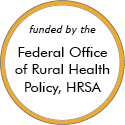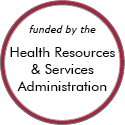Rural Project Examples: Access
Effective Examples
Vermont Hub-and-Spoke Model of Care for Opioid Use Disorder
Updated/reviewed November 2025
- Need: In the early 2010s, needed increase access to medication treatment for opioid use disorder in rural Vermont.
- Intervention: 2012-2016 implementation of a statewide hub-and-spoke treatment access system.
- Results: The original system's increased treatment capacity and care coordination successes now are a permanent system of integrated care overseen by the Vermont state health department and Vermont Blueprint for Health.
New Mexico Mobile Screening Program for Miners


Updated/reviewed April 2025
- Need: To increase access to medical screening for miners in New Mexico.
- Intervention: A mobile screening clinic with telemedicine capability screens miners for respiratory and other conditions.
- Results: In a survey, 92% of miners reported their care as very good, while the other 8% reported it as good. The program has expanded to three other states.
Franklin Cardiovascular Health Program (FCHP)
Updated/reviewed March 2025
- Need: To develop sustainable, community-wide prevention methods for cardiovascular diseases in order to change behaviors and healthcare outcomes in rural Maine.
- Intervention: Local community groups and Franklin Memorial Hospital staff studied mortality and hospitalization rates for 40 years in this rural, low-income area of Farmington to seek intervention methods that could address cardiovascular diseases.
- Results: A decline in cardiovascular-related mortality rates and improved prevention methods for hypertension, high cholesterol, and smoking.
The Health-able Communities Program

Updated/reviewed August 2024
- Need: Expand healthcare access for the more remote residents of 3 frontier counties in north central Idaho.
- Intervention: With early federal grant-funding, a consortium of healthcare providers and community agencies used a hybrid Community Health Worker model to augment traditional healthcare delivery services in order to offer a comprehensive set of health-related interventions to frontier area residents.
- Results: With additional private grant funding, success continued to build into the current model of an established and separate CHW division within the health system's population health department.
Promising Examples
The Rural Virtual Infusion Program

Updated/reviewed November 2025
- Need: Allow rural cancer patients in a region inclusive of 26 counties in Iowa, Minnesota, and South Dakota to have access to tertiary-level chemotherapy regimens administered in rural infusion centers.
- Intervention: With telehealth-based oversight from a tertiary care oncology team, 3 rural infusion teams were trained to coordinate cancer treatment plans and administer complex chemotherapy regimens.
- Results: The original grant-supported effort — with its results of saving130 patients 65,000 trip miles and 1,800 travel hours – proved sustainable.
Arkansas Rural Health Partnership Hospital-based Transitional Care Program

Added July 2024
- Need: Solutions for Medicare beneficiaries' post-acute care recovery gaps in Arkansas's southeast Delta Region.
- Intervention: Supported by federal funding and their membership organization, seven hospitals implemented an evidence-supported Critical Access Hospital transitional care model.
- Results: Participating hospitals found a significant increase in swing bed services revenue, an all-cause low readmission rate, high percentage of patients discharged to home or to an assisted living environment, and positive patient satisfaction surveys.
Health Extension Regional Offices (HEROs)
Updated/reviewed May 2024
- Need: People in rural New Mexico often found it difficult to find and utilize needed resources from the University of New Mexico Health Sciences Center (UNMHSC).
- Intervention: UNMHSC created Health Extension Regional Offices (HEROs), in which HERO agents live in the communities they serve, help identify health and social needs, and link them with UNMHSC and other university resources.
- Results: In their regions, HERO agents' activities have been wide-ranging, including recruiting physicians, mobilizing research funds to address local priorities, working on economic development, training laypeople in Mental Health First Aid, and helping local institutions access UNMHSC resources.
Other Project Examples
Angel Flight East's Rural & Rare Reach Program
Updated/reviewed November 2025
- Need: Free, non-emergency air travel for children and adults in need of medical treatment far from home who live in rural areas of the Northeast.
- Intervention: Angel Flight East, a free medical flight service, has expanded their focus to include more patients from rural areas, as well as those with rare medical conditions.
- Results: Since adding the Rural & Rare Reach program, Angel Flight East has made contact with over 100 Critical Access Hospitals and more than 300 FQHCs for referrals. Ongoing promotional efforts with rural health organizations are helping to increase the awareness of flight services to rural locations.
Healthy Adams County
Updated/reviewed November 2025
- Need: To create initiatives in rural Pennsylvania communities to address locally-identified health disparities.
- Intervention: Healthy Adams County was created by Adams County residents to promote community-wide health.
- Results: Community task forces have been formed to address healthcare access, female cancers, food policies, behavioral health, children's health & nutrition, domestic violence/sexual assault, and other community-identified needs.
Healthy Monadnock Alliance
Updated/reviewed November 2025
- Need: Improved health outcomes for Monadnock Region, a rural area of New Hampshire.
- Intervention: A wide-scale effort across multiple sectors is aiming to improve health outcomes throughout the region.
- Results: Community health trends have been tracked over time, and progress on goals such as increasing the number of residents with healthcare coverage, opportunities for physical activity, access to healthy foods, and smoking cessation has been made.
For examples from other sources, see:
